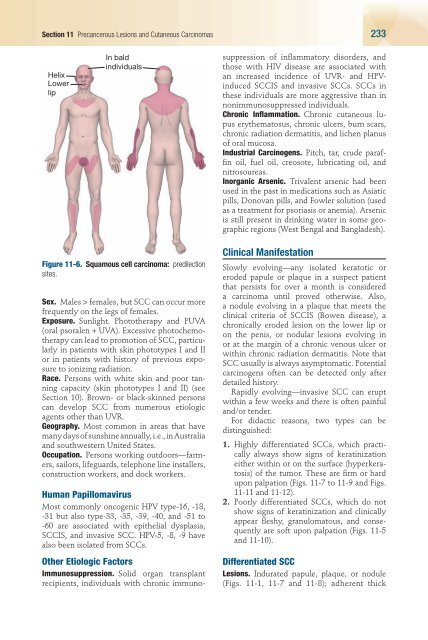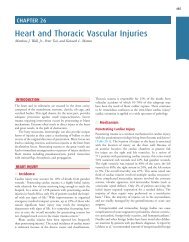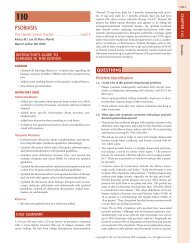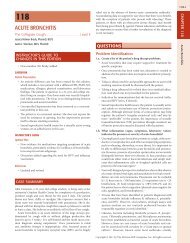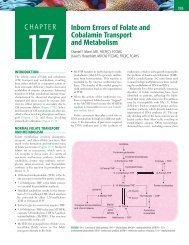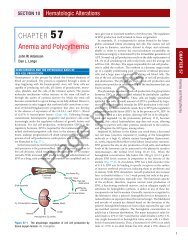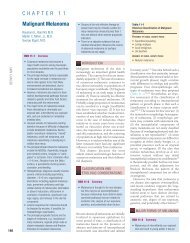TOC and Sample Chapters - McGraw-Hill Professional
TOC and Sample Chapters - McGraw-Hill Professional
TOC and Sample Chapters - McGraw-Hill Professional
Create successful ePaper yourself
Turn your PDF publications into a flip-book with our unique Google optimized e-Paper software.
Section 11 Precancerous Lesions <strong>and</strong> Cutaneous Carcinomas 233<br />
Helix<br />
Lower<br />
lip<br />
In bald<br />
individuals<br />
Figure 11-6. Squamous cell carcinoma: predilection<br />
sites.<br />
Sex. Males > females, but SCC can occur more<br />
frequently on the legs of females.<br />
Exposure. Sunlight. Phototherapy <strong>and</strong> PUVA<br />
(oral psoralen + UVA). Excessive photochemotherapy<br />
can lead to promotion of SCC, particularly<br />
in patients with skin phototypes I <strong>and</strong> II<br />
or in patients with history of previous exposure<br />
to ionizing radiation.<br />
Race. Persons with white skin <strong>and</strong> poor tanning<br />
capacity (skin phototypes I <strong>and</strong> II) (see<br />
Section 10). Brown- or black-skinned persons<br />
can develop SCC from numerous etiologic<br />
agents other than UVR.<br />
Geography. Most common in areas that have<br />
many days of sunshine annually, i.e., in Australia<br />
<strong>and</strong> southwestern United States.<br />
Occupation. Persons working outdoors—farmers,<br />
sailors, lifeguards, telephone line installers,<br />
construction workers, <strong>and</strong> dock workers.<br />
Human Papillomavirus<br />
Most commonly oncogenic HPV type-16, -18,<br />
-31 but also type-33, -35, -39, -40, <strong>and</strong> -51 to<br />
-60 are associated with epithelial dysplasia,<br />
SCCIS, <strong>and</strong> invasive SCC. HPV-5, -8, -9 have<br />
also been isolated from SCCs.<br />
Other Etiologic Factors<br />
Immunosuppression. Solid organ transplant<br />
recipients, individuals with chronic immuno-<br />
suppression of inflammatory disorders, <strong>and</strong><br />
those with HIV disease are associated with<br />
an increased incidence of UVR- <strong>and</strong> HPVinduced<br />
SCCIS <strong>and</strong> invasive SCCs. SCCs in<br />
these individuals are more aggressive than in<br />
nonimmunosuppressed individuals.<br />
Chronic Inflammation. Chronic cutaneous lupus<br />
erythematosus, chronic ulcers, burn scars,<br />
chronic radiation dermatitis, <strong>and</strong> lichen planus<br />
of oral mucosa.<br />
Industrial Carcinogens. Pitch, tar, crude paraffin<br />
oil, fuel oil, creosote, lubricating oil, <strong>and</strong><br />
nitrosoureas.<br />
Inorganic Arsenic. Trivalent arsenic had been<br />
used in the past in medications such as Asiatic<br />
pills, Donovan pills, <strong>and</strong> Fowler solution (used<br />
as a treatment for psoriasis or anemia). Arsenic<br />
is still present in drinking water in some geographic<br />
regions (West Bengal <strong>and</strong> Bangladesh).<br />
Clinical Manifestation<br />
Slowly evolving—any isolated keratotic or<br />
eroded papule or plaque in a suspect patient<br />
that persists for over a month is considered<br />
a carcinoma until proved otherwise. Also,<br />
a nodule evolving in a plaque that meets the<br />
clinical criteria of SCCIS (Bowen disease), a<br />
chronically eroded lesion on the lower lip or<br />
on the penis, or nodular lesions evolving in<br />
or at the margin of a chronic venous ulcer or<br />
within chronic radiation dermatitis. Note that<br />
SCC usually is always asymptomatic. Potential<br />
carcinogens often can be detected only after<br />
detailed history.<br />
Rapidly evolving—invasive SCC can erupt<br />
within a few weeks <strong>and</strong> there is often painful<br />
<strong>and</strong>/or tender.<br />
For didactic reasons, two types can be<br />
distinguished:<br />
1. Highly differentiated SCCs, which practically<br />
always show signs of keratinization<br />
either within or on the surface (hyperkeratosis)<br />
of the tumor. These are firm or hard<br />
upon palpation (Figs. 11-7 to 11-9 <strong>and</strong> Figs.<br />
11-11 <strong>and</strong> 11-12).<br />
2. Poorly differentiated SCCs, which do not<br />
show signs of keratinization <strong>and</strong> clinically<br />
appear fleshy, granulomatous, <strong>and</strong> consequently<br />
are soft upon palpation (Figs. 11-5<br />
<strong>and</strong> 11-10).<br />
Differentiated SCC<br />
Lesions. Indurated papule, plaque, or nodule<br />
(Figs. 11-1, 11-7 <strong>and</strong> 11-8); adherent thick


